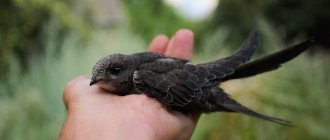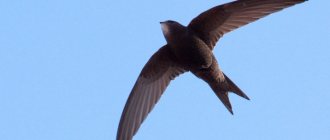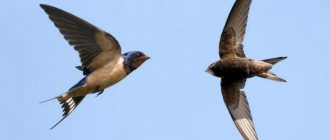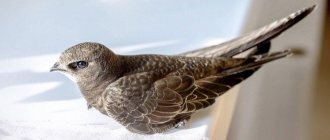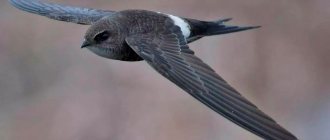How swifts sleep. Why do swifts sleep in the air?
An interesting feature of swifts is that they can sleep in the air.
And not for a few minutes, but for several hours, gliding high in the sky, occasionally moving its wings in its sleep. In the morning they wake up and begin their usual business - they begin to catch insects. Meanwhile, the whole answer is “why do swifts even sleep in the air? "It lies in their lifestyle.
This small bird appears much larger due to its unusually long wings. The swift reaches a length of up to 18 centimeters, with a wingspan of 40 centimeters. And his legs are small and weak, not at all suitable for walking. Therefore, one of the first scientific names of the swift, translated from Latin, was “Legless Swallow”. Now it becomes completely clear why no one saw him sitting on the ground - here this born flyer becomes completely helpless, unable to take off and doomed to death. Swifts can only sit on a branch or cling to a vertical rock with sharp claws.
During sharp summer cold snaps, when insects (the prey of swifts) disappear from the air, the body temperature of these birds may drop, and they temporarily fall into torpor. This is even more pronounced in chicks - adults can fly away from bad weather - babies become numb from cold and hunger, their temperature drops to 20 degrees, and in this state they steadfastly wait out the hunger strike for up to 9-12 days.
Swifts manage not only to sleep on the fly, but also to hover over the same place without being blown away by the wind. To find out how they do this, ornithologists Johan Beckman and Thomas Alrstam from Lund University in Sweden used radar to track the movement of swifts at night. As reported in the German scientific journal Bild der Wissenschaft, scientists have noticed certain patterns in the flight of sleeping swifts that allow them to stay above a certain place. Birds gain high altitude, up to three thousand meters, and then fly at an angle to the direction of the wind, changing flight direction every few minutes. Thanks to this rhythmicity, swifts continue to fly back and forth over the same place. But in light winds, as has been noted, swifts fly in circles in their sleep.
Swift is famous for its records. This is one of the fastest flying birds. The most flying bird - can stay in the air for 2-4 years. During all this time, he sleeps, drinks, eats and even mates on the fly. A young swift that takes flight probably flies 500,000 km before landing for the first time.
Despite the fact that swifts live literally above our heads, we know very little about them. Unlike other birds, they do not sing songs or chirp with other birds while sitting near their nests. It seems that they are in a hurry to raise and feed their offspring and prepare them for adulthood in a short summer. They are busy with everyday concerns and an idle life is simply not for them. However, black swifts, unlike songbirds, do not teach their chicks how to get food. They become independent as soon as they leave the parental nest.
They gradually fly away in August. They winter in Africa, in the south to the equator.
Many people sometimes confuse swifts with swallows. In some ways they are really similar: both are tireless flyers. But you can still distinguish swifts at first glance: their wings are crescent-shaped and narrower, and they fly swiftly and straight, not as nimble as swallows; and usually higher. If you ever manage to hold a swift in your hands, pay attention to its paws. They are small and not at all suitable for walking. Therefore, one of the first scientific names of the swift, translated from Latin, was “Legless Swallow”. Swallows, on the contrary, can walk on the ground and easily take off from a flat surface. The swift's beak is also small, but its throat is wide. This is understandable. Cutting through warm currents of air carrying myriads of midges, the swift takes a mouthful of food, coats it with saliva and then flies with this lump of food to the nest. Atmospheric pressure affects the distribution of insects in the air. Therefore, like swallows, on sunny days, swifts hunt at high altitudes, and in cloudy weather, they sometimes fly right over the ground.
What to feed the swift. Black swift: what to feed the chick and adult at home?
In late spring, it often happens that chicks fall out of the nest. Some manage to survive. Sometimes we happen to pick up an adult wounded bird. What to do if the foundling turns out to be a swift? What to feed this extremely picky bird at home? But let's first determine who is in front of us: a swallow (there are several species) or a swift.
Village women have 3 toes on their paws pointing forward and one toe pointing back. For city dwellers of black swifts, everything is different. They have 4 toes pointed forward like a foot. And adult individuals are even easier to identify: the swallow has a white shirtfront on its chest.
So, you are convinced that this is not a sparrow, not a wagtail or a killer whale, but a real Apus apus. In Russian - black swift. What to feed your foundling at home? In EU countries there are special shelters for wild animals and birds, where specialists care for them. Our only hope is in the mercy and patience of ordinary people. But, in addition to kindness and a desire to help, you also need to know what to feed these foundlings, since the wrong food can lead to the death of the animal.
It is important to determine how old the swift bird is in front of you. What do young animals eat and how often? Parents feed their chicks 50-70 times a day, but your pet can get by with one dose of food per hour. The entire diet consists of insects - crushed in the beak of the parents and compressed into a lump using their saliva. Birds shove this food deep into their young's throats. What should a city dweller who finds a haircut do? If the chick is very weak, you first need to give him a little water.
You need an insulin syringe with a removable needle. We put 2-3 cubes of warm boiled water into it. We wrap the chick in a napkin and take it with our left hand. With the right hand, we carefully open its beak and fix it with the nail of the index finger of the left hand. And then we introduce the liquid drop by drop onto the tongue. If a bird swallows water, it means that all is not lost, and it makes sense to fight for its life. A weakened haircut needs to be provided with heating (with a lamp or a heating pad). Place him in a box or bowl (but never in a cage) and give him something to eat as soon as possible. What to feed a swift chick? At first - because time is pressing - offer him baby meat puree. Roll into a ball and place it on the base of your tongue using tweezers with rounded tips.
But such a diet should not be permanent - a maximum of two days. Don't forget that he is an insectivore - this black swift. What to feed such a fussy person at home? Bread is contraindicated, as are eggs, food for parrots, canaries, dogs and cats. Only crickets, flies and their larvae, drones, ant eggs and wax moths. What are we doing? We order wax moth and cricket larvae from specialized pet stores or via online delivery. Contacting your local beekeepers association will provide you with drones. You can buy fly larvae in fishermen's stores. Half of them should be placed in a warm place so that adult insects hatch, and the rest should be placed in the refrigerator.
You will encounter much greater difficulties if you get your hands on an adult swift. What to feed a bird at home that is accustomed to catching insects on the fly? Until your pet recovers and is able to get its own food, you will have to provide it with live flies. And do not forget to give the bird water every time after feeding.
How swifts sleep in nature. Appearance and description of the black swift
Black swifts have a body reaching a length of 18 cm with a wingspan of 40 cm. The average wing length of an adult is approximately 16-17 cm. The forked tail of the bird is 7-8 cm long. The tail plumage is unremarkable, of an ordinary dark brown color with a slight greenish-metallic tint.
On short, but very strong legs, there are four forward-facing toes, which are equipped with fairly sharp and tenacious claws. With a body weight of 37-56 g, black siskins are perfectly adapted to their natural habitat, where their life expectancy is a quarter of a century, and sometimes more.
This is interesting! The black swift is the only bird capable of eating, drinking, mating, and sleeping while flying. Among other things, this bird can spend several years in the air, without landing on the surface of the earth.
With their shape, swifts resemble swallows. A rounded whitish spot is clearly visible on the throat and chin. The eyes have a dark brown color. The beak is black, and the paws are characterized by a light brown color.
The short beak has a very wide mouth opening. There are no differences in the plumage of males and females, but the peculiarity of young individuals is a lighter shade of feathers with a dirty white border. In summer, the plumage can fade greatly, so the appearance of the bird becomes even more inconspicuous.
Swift migration. Where do swift birds live, when do they arrive, what do they look like in the photo
After a long winter, swifts always return home. These birds inhabit almost the entire globe, not only in countryside areas, but also within the city. They are often confused with swallows because the birds are very similar in appearance. When do they arrive, what do swifts look like and what do they eat?
Description of the black swift: photo
Swifts are among the most common birds on earth. They live on all continents, with the exception of Antarctica and some oceanic islands. These are small birds with a dense and strong body. On a slightly elongated body there is a wide and flat head with a short neck. The bird's beak is very short, weak and triangular, and flattened at the end. The jaws of the beak are split very deeply due to which the beak can open as wide as possible.
The wings of swifts are narrow and curved, resembling a saber in shape. The black or tower swift can have a body size of up to 18 cm with a wingspan of 40 cm. The wing length reaches 17 cm and the tail 8 cm. Body weight ranges from 90 to 110 grams. The plumage of the bird is dark brown with a greenish tint. The chin and throat are decorated with a white collar, the bird's beak is black, its paws are light brown, and its eyes are dark brown. If you look closely at the photo of the black swift, you will see that it has a great resemblance to a swallow. In fact, they are united by external resemblance and a similar lifestyle.
Swifts are larger in size than swallows. They have short legs, allowing them to cling comfortably and firmly to a steep surface. They spend most of their lives flying, as they are virtually invulnerable in flight. On the ground, they can become prey for predators, so they rarely descend to the surface of the earth.
Habitats and lifestyle
This species of bird makes migratory flights. In the summer, they settle in large numbers in Western Siberia, China and so on to Spain. In the northern part of the planet, swifts choose Finland, Norway and the subarctic zones of Russia as nesting places. Black swifts breed their offspring in the southern territories:
- Algeria;
- Israel;
- Lebanon;
- Morocco:
- Near East.
Birds winter in southern Africa, as well as on the equator. They live most comfortably there. Swifts feel best when in flight. They always fly rapidly, and to turn they make a large turn. A distinctive feature of black swifts is the fact that while in flight the bird can:
- There is;
- mate;
- sleep.
There is no other bird in the world that can do this. They can spend 2-4 years in the air without landing on the ground. During the nesting season, they are forced to build nests for breeding. Basically, these birds live in flocks and always nest in colonies.
Swifts have 4 toes on their paws, pointing to the side, so it is difficult for them to maintain balance while sitting on the surface of the ground. They cannot move - jump, walk on their paws. For this reason, swifts are always in flight to protect themselves. It is believed that these birds are the fastest, since their flight speed reaches 120 km/h, and swallows can reach a maximum speed of 60 km/h. Swifts are always active from morning until evening. Their lifespan is about 20 years.
Nutrition
The lifestyle of swifts is greatly influenced by weather conditions. This also applies to the nutrition of birds. They depend on the environment and its temperature. Their activity and body temperature depend on nutrition. If swifts have nothing to eat, their body temperature can drop to 20°C. For this reason, birds often fall into “stupor.” Such hibernation is necessary for birds to preserve their last strength in case of food shortage. Swifts can spend several days in this motionless state. Condition will depend on weather conditions. This is especially acute in rainy weather, since there are no insects in the air.
While in flight, birds catch insects as if with a net under favorable weather conditions. Birds eat small flying insects. When there is no food, adults fly several kilometers to get food. At this time, the chicks remain in the nests and hibernate until their parents bring them food. Such flights are called weather migration. Winter flights will depend on weather conditions. If the weather is unfavorable, then swifts may fly away for the winter in August due to lack of food.
Reproduction
For nesting, swifts choose tree hollows, caves, rocks and burrows. The nesting location will depend on the bird's habitat. They can settle in mountains, forests, cities and deserts. Swifts are loyal and mate for life. To build a nest, parents obtain building material on the fly. It can be:
- twigs;
- feathers;
- plant fiber.
Birds pick up all this on the fly. After wintering, they return to their place and settle in old nests to breed. It takes about 1 week to build one nest. The female incubates the eggs for 16-22 days, during which time the male is engaged in food production. The female lays eggs, perhaps from 1 to 4 eggs per clutch.
The hatched chicks are completely helpless and remain in the nest constantly for 33-39 days. The number of days is always related to weather conditions. Caring parents try to feed their offspring several times a day with a mixture of saliva and insects. When the offspring are ready for independent life, then they fly away from the nest forever.
Birds swifts
Family life
These birds always build their nests very high and away from people. That is, so that during their absence the chicks are as safe as possible. Ideal for them is a mountain gorge. And within the city there is a hole between the roof and the wall, where people and other animals cannot climb.
If swifts choose a park or forest as their home, then the oldest and most branched tree that can withstand gusts of wind without strong swaying will be chosen. But even with strong gusts of wind, they hold on well with the help of sharp claws.
Where do swifts live? Character and lifestyle
These birds prefer to live in colonies. This way of life helps them keep everything under control, observe the changes around them and escape from possible danger in time.
Swifts are highly dependent on surrounding natural factors, climate and temperature conditions. The favorite pastime of swifts, if they are not in flight, is to sit on steep rocks, to which they skillfully cling with sharp claws.
Good nutrition is important for swifts. If they have problems with food, which especially often happens during cold periods, the swifts seem to turn on a reduced consumption of their “battery”. In other words, they become less active, as if they are in a mysterious daze. This helps the bird expend much less energy than usual.
This state can last up to several days, until better weather conditions arrive and it becomes possible to get food for yourself. It is also typical for small chicks.
But for them the reason for it is something else. This way the kids can wait for their parents to return from the hunt. The waiting time can last about 9 days. In total, swifts are active from early morning until evening.
Swifts migrate to wintering in warmer climes starting in August. Although it is impossible to determine the exact time for this, it all depends on the weather. If, in general, the weather conditions of the swifts are completely satisfactory, migration may be completely postponed.
Therefore, about some swifts we can say that they are sedentary birds. Such sedentary swifts are especially abundant in large cities, where the air temperature is usually higher than in a forest or steppe, for example.
Swift chick
According to the description, the swift bird has a hot temper. They cannot be called cunning or cautious. These big bullies have been seen more than once as instigators of fights in their circle or with other birds.
Often such fights are quite serious. At such moments, swifts forget about any caution and completely indulge in “war.” In flight, swifts are practically not disturbed or threatened by anything. The only bird that the swift should be wary of is the falcon.
Choosing a place to live
Although siskins rarely change their registration, they can fly tens and even hundreds of kilometers for the winter or due to danger to life. Swifts can be found everywhere - from China to Turkey, from Siberia to Spain.
But each region has its own subspecies, this could be:
- Black;
- White;
- Palm;
- Spinetail;
- White-bellied;
- Barbel.
But the actual number of subspecies reaches 80. Now they have not yet been studied enough and few people will undertake to analyze the distinctive features in a group of common characteristics. But, undoubtedly, they have their own characteristics.
Swifts sleep in flight. Lifestyle and habitat
Most often, the swift is found in the company of its fellows. They nest in small colonies, noisy in nature. The swift is a loud bird that spends almost its entire life in flight. In the evenings on clear days, individuals organize peculiar “races”, which are accompanied by interesting turns and frequent screams, reminiscent of the piercing screech of “strii” or “weeeeeeeeeeeee”.
The black or common swift is a cocky bird; it can enter into a fight with an opponent for victory. Often such conflicts end in trouble: from feathers being pulled out to fractures.
Like other migratory birds, the swift migrates to warm countries for the winter. In summer they live in Siberia, the Far East, and Europe. Swifts wait out the cold season in warm countries: Israel, Morocco, Algeria, Georgia and others.
In the central part of Russia, the bird leaves its nests by mid-September, and returns only in early May, when the first leaves appear on the trees. In warmer areas, it leaves for the winter by the end of October.
Interesting fact
People see swifts almost every day. But due to their discreet color, it is unlikely that anyone will remember such a last meeting. When in a hurry, a swift may generally seem similar to a young pigeon, which is why people think that it is not a swift.
Swifts are the birds that are the first to sense the arrival of spring and begin to scream under the windows. The voice, by the way, is very loud and disgusting to people. It is difficult to confuse it with other birds. This is due to the strong dependence of swifts on the weather; they sense a change in the weather in advance and begin to prepare for it.
Usually, swifts build their nests for many years, and after a winter in foreign lands, they return to their old place. One can endlessly marvel at the memory of these birds, but if they survive the winter well, they will definitely return to their native nest. They build their house in old trees or in small cracks under the roof of a human dwelling.
